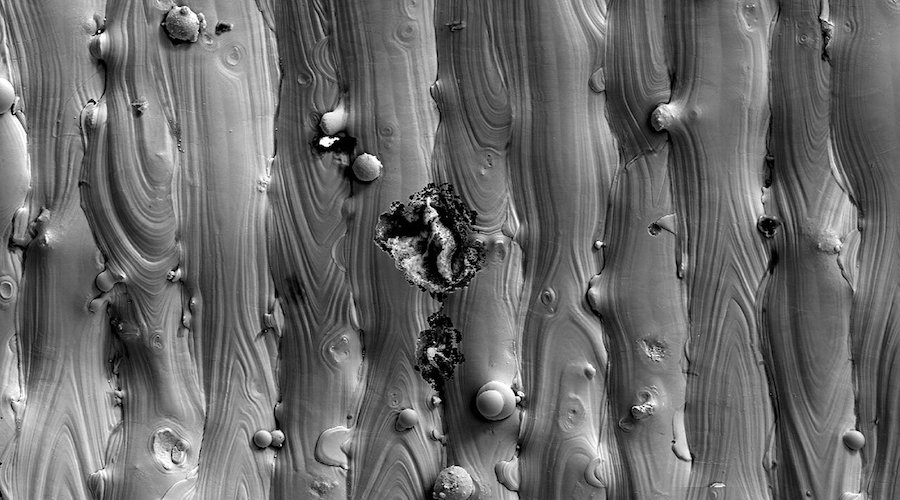Slags are produced by deoxidizers such as manganese and silicon. In traditional stainless steel 316L manufacturing, these elements are typically added before casting to bind with oxygen and form a solid phase in the molten liquid metal that can be easily removed post-manufacturing.
The LLNL researchers found these slags also form during laser powder bed fusion (LPBF) 3D printing but remain at the metal’s surface and initiate pitting corrosion.
“Pitting corrosion is extremely difficult to understand due to its stochastic nature, but we determined the material characteristics that cause or initiate this type of corrosion,” Shohini Sen-Britain, lead author of the Nature Communications paper that presents the findings, said in a media statement.
3D-printing steel.
“While our slags looked different than what had been observed in conventionally manufactured materials, we hypothesized that they could be a cause of pitting corrosion in 316L,” Sen-Britain said. “We confirmed this by taking advantage of the impressive materials characterization suite and modelling capabilities we have at LLNL, where we were able to prove without a doubt that slags were the cause. This was extremely rewarding.”
While slags can also form during traditional stainless steel manufacturing, they’re typically removed with chipping hammers, grinders, or other tools. In the scientists’ view, however, those post-processing options would defeat the purpose of additive manufacturing (AM) the metal.
Zooming in on slags
The team used a combination of advanced techniques, including plasma-focused ion beam milling, transmission electron microscopy, and X-ray photoelectron spectroscopy on AM stainless steel components.
They were able to zoom in on the slags and uncover their role in the corrosion process in a simulated ocean environment, finding they created discontinuities and allowed the chloride-rich water to penetrate the steel and wreak havoc. Additionally, the slags contain metal inclusions that dissolve when exposed to the seawater-like environment, further contributing to the corrosion process.
“We wanted to do a deep-dive microscopy study to figure out what could potentially be responsible for corrosion when it does happen in these materials, and if that’s the case, then there may be additional ways of improving them by avoiding that particular agent,” Brandon Wood, the project’s principal investigator, said. “There is a secondary phase that is formed that contains manganese—these slags—that appeared to be what was most responsible. Our team did some additional detailed microscopy looking at the neighbourhood of those slags, and sure enough, we were able to show that in that neighbourhood, you have enhancement—a secondary indicator that this is probably the dominant agent.”
Using transmission electron microscopy, the researchers selectively lifted small samples of 3D-printed stainless steel from the surface—about a few microns—to visualize the slags through the microscope and analyze their chemistry and structure at atomic resolution.
Keeping an eye on corrosion
The characterization techniques helped shed light on the complex interplay of factors that lead to pitting corrosion and enabled the team to analyze slags in ways never done before in AM.
“During the process, you locally melt the material with the laser, and then it solidifies very rapidly,” lead investigator Thomas Voisin said. “The rapid cooling freezes the material in a non-equilibrium state; you’re basically keeping the atoms in a configuration that is not supposed to be, and you’re changing the mechanical and corrosion properties of the material.”
Voisin pointed out that keeping an eye on corrosion is very important when working with stainless steel because it is used in marine applications.
“You could have the best material with the best mechanical properties, but if it cannot be in contact with seawater, this is going to restrict the applications significantly,” he said.
The group noted that this study marks a significant step forward in the ongoing battle against corrosion, not only deepening scientific understanding of corrosion processes but also paving the way for developing improved materials and manufacturing techniques.
By unravelling the mechanisms behind the slags and their relationship to pitting corrosion, engineers and manufacturers can strive to create stainless steel components that are not only strong and durable but also highly resistant to the corrosive forces of seawater, with implications extending beyond the realm of marine applications and into other industries and kinds of harsh environments.
Now that the team understands the causes behind pitting, Sen-Britain and Voisin said the next steps to enhancing the performance and longevity of 3D-printed stainless steel 316L would be altering the formulation of the powder feedstock to remove manganese and silicon to limit or eliminate slag formation.
This article was published by: Valentina Ruiz Leotaud
Visit the original article here



